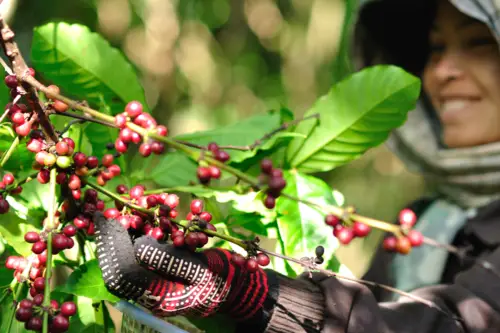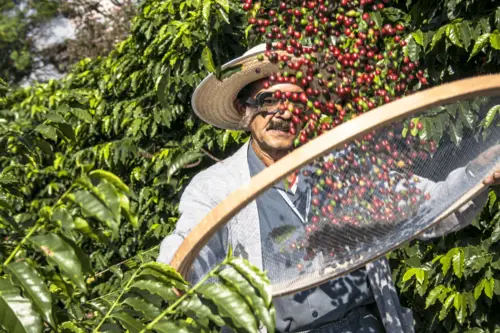Have you ever thought about the path the coffee you drink every morning takes before it reaches your table? Well, each bean must first go through the coffee harvest and the so-called post-harvest. The method of harvesting the coffee will be the determinant of the value of the bean and also the value of the harvest or load of coffee.
Therefore, the beginning of the coffee journey is an aspect of utmost care. The responsibility for a good harvest lies in the hands of the coffee growers. This is why every day, the farmers apply better techniques or processes so that the best coffee beans are destined for drying, threshing and grinding, which results in the commercialisation of the coffee.

When is coffee harvested?
Like other agricultural crops, coffee begins to be harvested when its fruit has reached maturity. This can be appreciated when the coffee cherry or fruit takes on intense red colour. The period from the flowering of the coffee to the ripening of the fruit can take between 6 and 8 months. During this period, the fruit turns from a deep green to a yellowish colour, followed by orange and finally red.
Unlike other crops, coffee finishes its ripening process when it is harvested, so harvesting is almost obligatory. The art of coffee harvesting varies from country to country and from coffee variety to coffee variety, but in all of them, the key role is to know the optimal time to harvest.
How often is coffee harvested?
As for the times or periods in which coffee is harvested, it all depends on the geographical area in which the crop is grown. Coffee-producing countries have established harvesting periods, although they may vary depending on weather conditions. For example, in Colombia, it is common to observe that the coffee harvesting season takes place between April and May. However, the harvest is smaller compared to the one that takes place between September and December.
Likewise, weather conditions lead to high or low harvest abundance. Consequently, areas with low rainfall have a gradual flowering and ripening of the coffee, while at the same time, the harvest is spread out over time.
What methods are used to harvest coffee?
As mentioned above, depending on the location and geographical conditions of each country, the best method of coffee harvesting is determined. Below you will find the most popular forms of coffee harvesting.

- Striping: as the name suggests, this method of harvesting coffee consists of scraping all the fruits from the branch without distinguishing the degree of ripeness. As a result, the harvest can include both ripe and green beans. However, this method requires a second check through which beans that are too green are discarded. Scraping is common in extensive plantations and in crops that reach maturity at the same time.
- Manual or selective harvesting: the mechanism requires harvesting by hand grain by grain, selecting only the ripe cherries and leaving on the plant the grains that are not yet ripe. Although it is quite time-consuming and requires extensive knowledge of coffee, its effort results in a higher quality coffee. However, it obliges the coffee grower to harvest the beans that were not ready. As for its preferred areas, it is more common in higher altitudes where the climate means that the beans do not ripen homogeneously.
- Mechanical harvesting: this method relies on machines that detach the branches of the coffee trees, so that the beans are mixed with the leaves of the plant. There are also other types of machines that vibrate the trunk of the plant so that the beans fall to the ground and are then harvested by hand by the farmers.
What is post-harvest?
Finally, coffee harvesting ends with post-harvesting, a process in which the beans are extracted from the coffee pulp. This process can be carried out in two different ways. The first is natural drying, where the fruits are exposed to the sun for 1 or 2 weeks so that they can dry and the separation of the beans is not too time-consuming.
The second is by means of a pulper, which uses water to remove the remains of mucilage by fermenting the grains, which are left to soak for a couple of hours. However, this method requires another manual drying process to remove the excess moisture from the grains, with the aim that this moisture does not exceed 12%.
As you can see, harvesting the coffee is only the first step in obtaining the commercial product you enjoy every morning. However, it is a long process, divided into stages, which requires the separation of the beans from the pulp and subsequent drying. To obtain ground coffee, the dried beans must pass through threshing machines and then be ground according to their variety of origin.
